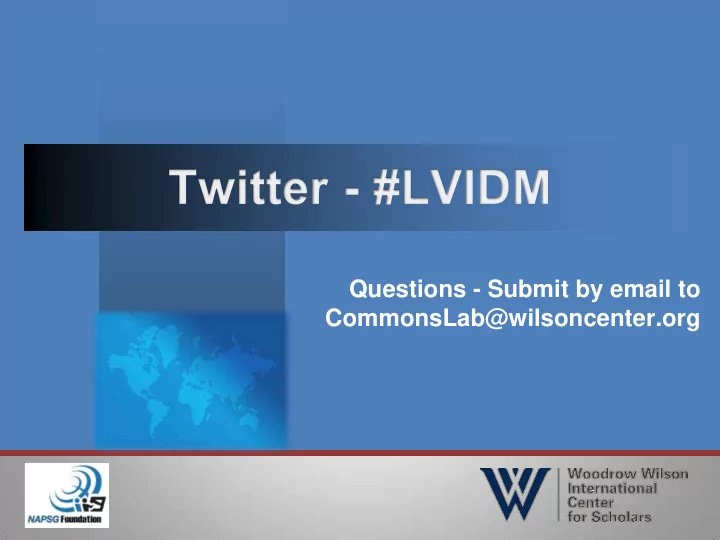

Questions - Submit by email to CommonsLab@wilsoncenter.org
Part 1 – Domestic Emergency Preparedness
Non-Profit Organization – 501 (c) 3 Practitioner-led Board of Directors Regional Leadership Teams 9 FEMA Regions 3,000+ National Practitioner Network Interdisciplinary - fire, police, emergency mgt, health… 800+ State & Local Agencies Coordination with other National Public Safety & GIS Organizations
Deep epwat ater Horizon izon Oil Spill, ll, April il 2010 Brisbane isbane Flood ood, Januar ary Chile le Ear arthq hquak ake, , Febr bruar ary 2010 2011 Structure Fire Times mes Squar quare e Bombing mbing Pipeline line Explo losio ion Everyday Incident Attem empt, , May 2010 Septembe mber 2010
Map 1 – Four Mile Canyon Fire, CO Map 2 – Salt Fire, CO What is the difference between the fire perimeters in the two maps? Map 1 – Public collaboration map, generated by a citizen, consumed by local news organization, no information about the source of data, received over 2.5 million views Map 2 – Produced by local emergency response agency (Type III IMT), used authoritative accurate data, map serves as public information tool to community
What are the potential liabilities associated with producing or using any type of crowdsourced or volunteered information product in response to an emergency? What can the emergency response community rely on crowdsourced information, volunteered geographic information, or crisis mapping products for? What strategies can be employed to reduce risks and liability exposure?
Starting point to inform the development of a coordinated strategy & practical guidance on how the emergency response community engages with the volunteer & technical communities and uses crowdsourced & volunteered information.
Crowdsourcing – the act of outsourcing tasks – observations, data collection & analysis - to a large group of people (a crowd) Crowdsourced – Aggregated information generated by the crowd and filtered by volunteer communities of interest Crisis Map – Map product generated in response to an emergency, using open data, & produced by volunteer communities of interest Volunteered Geographic Information – VGI – geo- referenced data provided by any individual Volunteered Information – citizen-generated information provided via social media or other collaborative environments
Volunteer & Technology Communities – V&TC - Independent people that informally convene (virtually & in-person) to contribute their skills & expertise with the intent to be of service in times of crisis. Emergency Response Community – ERC - Official government agencies & sanctioned volunteer organizations that provide public services in public safety, emergency management & homeland security
2:00pm Welcome & Introduction from Woodrow Wilson Center & NAPSG 2:10pm Remarks from a Panel of Experts 3:00pm Moderated Discussion – Q&A 3:50pm Closing & Wrap-Up 4:00pm Panel Adjourned R efreshments & informal discussion
Submit by email to CommonsLab@wilsoncenter.org Follow discussion via Twitter #LVIDM
Recommend
More recommend